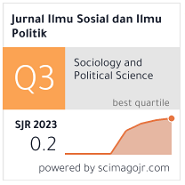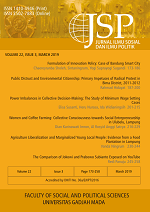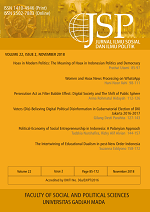Twitter Based Digital Social Movement Pattern to Fight COVID-19
Mohammad Thoriq Bahri(1*), Derajad Sulistyo Widhyharto(2)
(1) Faculty of Law and Political Sciences, University of Szeged, Hungary & Directorate General of Immigration, Ministry of Law and Human Rights, Republic of Indonesia, Indonesia
(2) Department of Sociology, Faculty of Social and Political Sciences, Universitas Gadjah Mada, Indonesia
(*) Corresponding Author
Abstract
Keywords
Full Text:
PDFReferences
Adalat, M., & Niazi, M. A. (2017). Evaluating Roles of Central Users in Online Communication Networks: A Case Study of #PanamaLeaks. http://arxiv.org/abs/1711.06845
Barbier, G., Feng, Z., Gundecha, P., & Liu, H. (2013). Provenance Data in Social Media. Synthesis Lectures on Data Mining and Knowledge Discovery, 4(1), 1–84. https://doi.org/10.2200/S00496ED1V01Y201304DMK007
Bernard, A. (2019). Theory of the Hashtag, Cambridge: Polity Press. Polity Press.
Binder, T. (2020, May 3). #Covid 19 – Twitter evolution.
Bode, L., Hanna, A., Yang, J., & Shah, D. v. (2015). Candidate Networks, Citizen Clusters, and Political Expression: Strategic Hashtag Use in the 2010 Midterms. Annals of the American Academy of Political and Social Science, 659(1), 149–165. https://doi. org/10.1177/0002716214563923
Borgatti, S., Everett, M., & Freeman, L. (1992). UCINET IV : Network Analysis Software.Connections Journal, 15(1), 12–15.
Brunker, F., Wischnewski, M., Mirbabaie, M., & Meinert, J. (2020). Hawaii International Conference on System Sciences 2020. (Vol.53).
Derek, R., & Jürgen, P. (2014). Social media for large studies of behavior. Science, 346 (6213), 1063–1064. https:/ / doi. org/10.1126/science.346.6213.1063
Dewantara, R. W., & Widhyharto, D. S. (2016). Aktivisme dan Kesukarelawanan dalam Media Sosial Komunitas Kaum Muda Yogyakarta. Jurnal Ilmu Sosial Dan Ilmu Politik, 19(1), 40. https://doi.org/10.22146/ jsp.10855
Flesher Fominaya, C. (2010). Collective Identity in Social Movements: Central Concepts and Debates. Sociology Compass, 4(6), 393–404. https:// doi.org/https:/ /doi. org/10.1111/j.1751-9020.2010.00287.x
Isa, D., & Himelboim, I. (2018). A Social Networks Approach to Online Social Movement: Social Mediators and Mediated Content in #FreeAJStaff Twitter Network. Social Media and Society, 4(1). https://doi.org/10.1177/2056305118760807
Larson, J. M., Nagler, J., Ronen, J., & Tucker, J. A. (2019). Social Networks and Protest Participation: Evidence from 130 Million Twitter Users. Source: American Journal of Political Science, 63(3), 690–705. https://doi. org/10.7910/DVN/RLLLlV
Mattoni, A., & Treré, E. (2014). Media Practices, Mediation Processes, and Mediatization in the Study of Social Movements. Communication Theory, 24(3), 252–271. https://doi.org/https://doi.org/10.1111/ comt.12038
Navarria, G. (2019). The Networked Citizen. Springer Singapore. https://doi.org/10.1007/978-981-13-3293-7
Papacharissi, Z., & de Fatima Oliveira, M. (2012). Affective News and Networked Publics: The Rhythms of News Storytelling on #Egypt. Journal of Communication, 62(2), 266–282. https://doi.org/10.1111/j.1460-2466.2012.01630.x
Park, S., Lee, J., Ryu, S., & Hahn, K. S. (2015). The Network of Celebrity Politics: Political Implications of Celebrity Following on Twitter. Annals of the American Academy of Political and Social Science, 659(1), 246–258. https://doi.org/10.1177/0002716215569226
Petrič, G. (2006). Conceptualizing and Measuring the Social Uses of the Internet: The Case of Personal Web Sites. The Information Society, 22(5), 291–301. https:// doi.org/10.1080/01972240600904159
Poell, T., & Dijck, J. van. (2017). Social media and new protest movements. https://www. researchgate.net/publication/321781377
Polletta, F., & Jasper, J. M. (2001). Collective Identity and Social Movements. Annual Review of Sociology, 27(1), 283–305. https:// doi.org/10.1146/annurev.soc.27.1.283
Pond, P., & Lewis, J. (2019). Riots and Twitter: connective politics, social media and framing discourses in the digital public sphere. Information, Communication & Society, 22(2), 213–231. https://doi.org/10.1080/1369118X.2017.1366539
Porta, D. della, & Diani, M. (2020). Social Movements: An Introduction, 3rd Edition (Vol. 3). Wiley Blackwell.
Sierra-Caballero, F. (2018). Cyberactivism and social movements. The Oppositional Public Space in contemporary technopolitics. https:// doi.org/10.4185/RLCS-2018-1292en
Smith, M. A., Rainie, L., Shneiderman, B., & Himelboim, I. (2014, February 20). Mapping Twitter Topic Networks: From Polarized Crowds to Community Clusters. Pew Research Center. https://www. pewresearch.org/internet/2014/02/20/ mapping-twitter-topic-networks-from- polarized-crowd s-to-comm unity- clusters/
Welser, H. T., Gleave, E., Fisher, D., & Smith, M. (2007). Visualizing the Signatures of Social Roles in Online Discussion Groups. In Journal of Social Structure (Vol. 8, Issue 2).
Wolfsfeld, G., Segev, E., & Sheafer, T. (2013). Social Media and the Arab Spring: Politics Comes First. International Journal of Press/Politics, 18(2), 115–137. https://doi.org/10.1177/1940161212471716
World Health Organization. (2020, May 3). Timeline: WHO’s COVID-19 response. WHO COVID-19 Updates.
Yates, L. (2015). Everyday politics, social practices and movement networks: daily life in Barcelona’s social centres. The British Journal of Sociology, 66(2), 236–258. https://doi.org/https://doi.org/10.1111/1468-4446.12101
Article Metrics
Refbacks
- There are currently no refbacks.
Copyright (c) 2021 Jurnal Ilmu Sosial dan Ilmu Politik

This work is licensed under a Creative Commons Attribution-NonCommercial-NoDerivatives 4.0 International License.






















